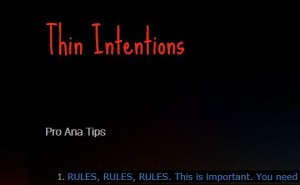In the early 2000s, a great deal of concern was raised about so called pro-ana or pro-mia websites that to varying degrees seemed to endorse and even promote eating disorders such as anorexia and bulimia. The alarm was loud enough to trigger an episode of the Oprah Winfrey Show in October 2001 on the subject. After that, however, public attention about this issue faded.
What has happened since? Especially with all of the significant changes and development of social media over the last decade, it certainly seems worth a look. Belgian researcher Kathleen Custers did just that in a recent review published in the European Journal of Pediatrics.
While the subject remains infrequently studied, several conclusions can be made. First, this content remains widely available and heavily accessed. Rough estimates are that ap proximately 13% of young female teens overall have visited pro-ED sites with the rate nearly tripling among those who manifest problematic eating disorder behaviors. One study reported that pro-ED content is searched on Google 13 million times per year.
proximately 13% of young female teens overall have visited pro-ED sites with the rate nearly tripling among those who manifest problematic eating disorder behaviors. One study reported that pro-ED content is searched on Google 13 million times per year.
Secondly, the sites have not changed drastically in terms of content or demographic. While social media has provided more of a venue for direct interaction among users of this content, the sites themselves continue frequently to display many of the same elements they have all along. These include “thinspiration” photos of extremely thin women (sometimes photoshopped to make people look even thinner) in addition to tips and tricks that can be used to lose weight and evade detection. A large percentage of these websites continue to be designed and run by adolescents and young women who struggle with eating disorders themselves.
Some controversy does exists about how destructive these sites are for people with eating disorders. While the stereotype of the pro-ana sites is that they unequivocally try to get people to continue to starve themselves, the sites do vary quite a bit in how much ambivalence is expressed about seeking help and change. Further, given the level of alienation that many individuals with eating disorders experience, some have argued that these sites provide a rare space for nonjudgmental support and reflection and thus may actually be providing a beneficial role. Research data, however, tends to demonstrate more of the harmful effects. Survey studies have shown that those who visit these sites report more dissatisfaction with their appearance while in the process picking up new methods for losing weight and hiding their struggles from others. The chicken or egg question, however, can easily be raised here as it is likely that some of these attitudes are driving traffic to these sites rather than the other way around. More solid evidence comes from a few studies that have turned to more experimental models. In these studies usually done with college age women, some are randomly assigned to viewing pro-eating disorder sites versus other type of content for a period of time and then their beliefs and behaviors are tracked. Some of these studies have found similar results as the surveys, and in a small percentage of subjects the viewing has prompted fairly drastic levels of calorie restriction.
The article concludes with some advice for both health professionals and parents. Clinicians are encouraged to become acquainted with pro-ED messages on the internet and to ask their patients about it. Custers suggests that patients keep a media diary while recording their feelings about themselves. She does not advise clinicians to expressly forbid patient to go to those sites, especially for those who are not yet ready to consider changing their behavior.
For more informational and recovery oriented sites, she recommends that they use celebrities more to promote treatment and positive change since the pro-ED sites are often focused on celebrity issues. Parents also are reminded to be aware of these sites, especially with how easily they can now be accessed with portable devices anytime and almost anywhere.
In reading this article, I worried a little that bringing up the topic might actually cause some youth to explore these kinds of sites even more. We’ve been taught for years that you can’t induce serious suicidal thinking in people by bringing up the subject, but here things feel a little different. On the other hand, it is difficult to think that most of us old timers would be ahead of our younger patients when it comes to knowledge about what is out there on the internet. I currently try to bring up the subject with patients who currently have problem eating behaviors but not for all adolescents in general. Please feel free to comment about your own thoughts and practices.
The article was a nice reminder that this topic has not disappeared with AOL but is taking different forms. While few would argue that culture and media are the sole drivers of eating disorders, their role is clearly important and deserving of this kind of investigation.
Reference
Custers K. The urgent matter of online pro-eating disorder content and children: clinical practice. Eur J Pediatrics 2015;174:429-433.
Tags: anorexia, bulimia, Eating Disorders, pro-ana, pro-mia

